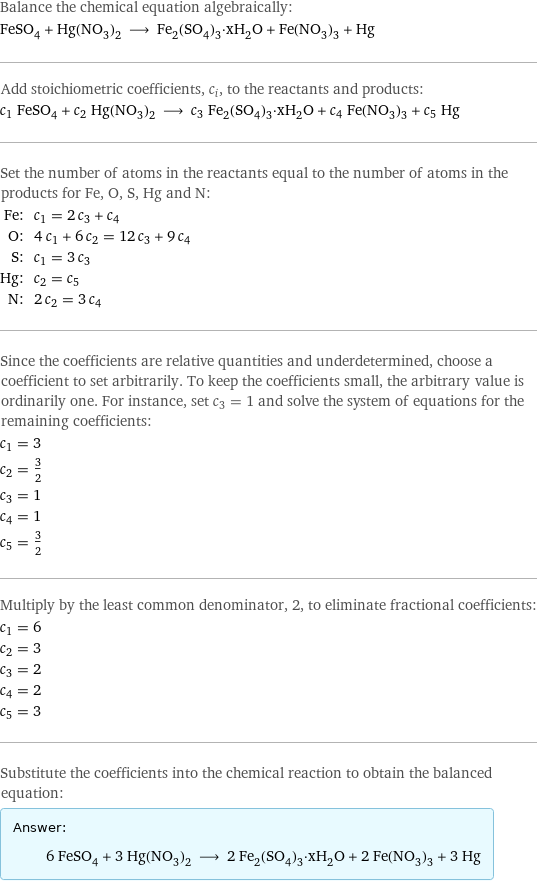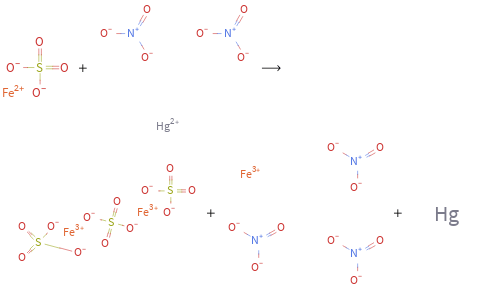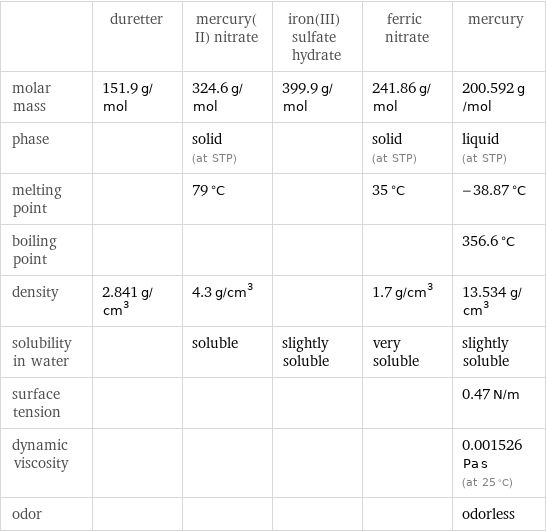Input interpretation

FeSO_4 duretter + Hg(NO_3)_2 mercury(II) nitrate ⟶ Fe_2(SO_4)_3·xH_2O iron(III) sulfate hydrate + Fe(NO_3)_3 ferric nitrate + Hg mercury
Balanced equation

Balance the chemical equation algebraically: FeSO_4 + Hg(NO_3)_2 ⟶ Fe_2(SO_4)_3·xH_2O + Fe(NO_3)_3 + Hg Add stoichiometric coefficients, c_i, to the reactants and products: c_1 FeSO_4 + c_2 Hg(NO_3)_2 ⟶ c_3 Fe_2(SO_4)_3·xH_2O + c_4 Fe(NO_3)_3 + c_5 Hg Set the number of atoms in the reactants equal to the number of atoms in the products for Fe, O, S, Hg and N: Fe: | c_1 = 2 c_3 + c_4 O: | 4 c_1 + 6 c_2 = 12 c_3 + 9 c_4 S: | c_1 = 3 c_3 Hg: | c_2 = c_5 N: | 2 c_2 = 3 c_4 Since the coefficients are relative quantities and underdetermined, choose a coefficient to set arbitrarily. To keep the coefficients small, the arbitrary value is ordinarily one. For instance, set c_3 = 1 and solve the system of equations for the remaining coefficients: c_1 = 3 c_2 = 3/2 c_3 = 1 c_4 = 1 c_5 = 3/2 Multiply by the least common denominator, 2, to eliminate fractional coefficients: c_1 = 6 c_2 = 3 c_3 = 2 c_4 = 2 c_5 = 3 Substitute the coefficients into the chemical reaction to obtain the balanced equation: Answer: | | 6 FeSO_4 + 3 Hg(NO_3)_2 ⟶ 2 Fe_2(SO_4)_3·xH_2O + 2 Fe(NO_3)_3 + 3 Hg
Structures

+ ⟶ + +
Names

duretter + mercury(II) nitrate ⟶ iron(III) sulfate hydrate + ferric nitrate + mercury
Equilibrium constant
![Construct the equilibrium constant, K, expression for: FeSO_4 + Hg(NO_3)_2 ⟶ Fe_2(SO_4)_3·xH_2O + Fe(NO_3)_3 + Hg Plan: • Balance the chemical equation. • Determine the stoichiometric numbers. • Assemble the activity expression for each chemical species. • Use the activity expressions to build the equilibrium constant expression. Write the balanced chemical equation: 6 FeSO_4 + 3 Hg(NO_3)_2 ⟶ 2 Fe_2(SO_4)_3·xH_2O + 2 Fe(NO_3)_3 + 3 Hg Assign stoichiometric numbers, ν_i, using the stoichiometric coefficients, c_i, from the balanced chemical equation in the following manner: ν_i = -c_i for reactants and ν_i = c_i for products: chemical species | c_i | ν_i FeSO_4 | 6 | -6 Hg(NO_3)_2 | 3 | -3 Fe_2(SO_4)_3·xH_2O | 2 | 2 Fe(NO_3)_3 | 2 | 2 Hg | 3 | 3 Assemble the activity expressions accounting for the state of matter and ν_i: chemical species | c_i | ν_i | activity expression FeSO_4 | 6 | -6 | ([FeSO4])^(-6) Hg(NO_3)_2 | 3 | -3 | ([Hg(NO3)2])^(-3) Fe_2(SO_4)_3·xH_2O | 2 | 2 | ([Fe2(SO4)3·xH2O])^2 Fe(NO_3)_3 | 2 | 2 | ([Fe(NO3)3])^2 Hg | 3 | 3 | ([Hg])^3 The equilibrium constant symbol in the concentration basis is: K_c Mulitply the activity expressions to arrive at the K_c expression: Answer: | | K_c = ([FeSO4])^(-6) ([Hg(NO3)2])^(-3) ([Fe2(SO4)3·xH2O])^2 ([Fe(NO3)3])^2 ([Hg])^3 = (([Fe2(SO4)3·xH2O])^2 ([Fe(NO3)3])^2 ([Hg])^3)/(([FeSO4])^6 ([Hg(NO3)2])^3)](../image_source/7830198e57ff42b3dddb2f7bc97db0a1.png)
Construct the equilibrium constant, K, expression for: FeSO_4 + Hg(NO_3)_2 ⟶ Fe_2(SO_4)_3·xH_2O + Fe(NO_3)_3 + Hg Plan: • Balance the chemical equation. • Determine the stoichiometric numbers. • Assemble the activity expression for each chemical species. • Use the activity expressions to build the equilibrium constant expression. Write the balanced chemical equation: 6 FeSO_4 + 3 Hg(NO_3)_2 ⟶ 2 Fe_2(SO_4)_3·xH_2O + 2 Fe(NO_3)_3 + 3 Hg Assign stoichiometric numbers, ν_i, using the stoichiometric coefficients, c_i, from the balanced chemical equation in the following manner: ν_i = -c_i for reactants and ν_i = c_i for products: chemical species | c_i | ν_i FeSO_4 | 6 | -6 Hg(NO_3)_2 | 3 | -3 Fe_2(SO_4)_3·xH_2O | 2 | 2 Fe(NO_3)_3 | 2 | 2 Hg | 3 | 3 Assemble the activity expressions accounting for the state of matter and ν_i: chemical species | c_i | ν_i | activity expression FeSO_4 | 6 | -6 | ([FeSO4])^(-6) Hg(NO_3)_2 | 3 | -3 | ([Hg(NO3)2])^(-3) Fe_2(SO_4)_3·xH_2O | 2 | 2 | ([Fe2(SO4)3·xH2O])^2 Fe(NO_3)_3 | 2 | 2 | ([Fe(NO3)3])^2 Hg | 3 | 3 | ([Hg])^3 The equilibrium constant symbol in the concentration basis is: K_c Mulitply the activity expressions to arrive at the K_c expression: Answer: | | K_c = ([FeSO4])^(-6) ([Hg(NO3)2])^(-3) ([Fe2(SO4)3·xH2O])^2 ([Fe(NO3)3])^2 ([Hg])^3 = (([Fe2(SO4)3·xH2O])^2 ([Fe(NO3)3])^2 ([Hg])^3)/(([FeSO4])^6 ([Hg(NO3)2])^3)
Rate of reaction
![Construct the rate of reaction expression for: FeSO_4 + Hg(NO_3)_2 ⟶ Fe_2(SO_4)_3·xH_2O + Fe(NO_3)_3 + Hg Plan: • Balance the chemical equation. • Determine the stoichiometric numbers. • Assemble the rate term for each chemical species. • Write the rate of reaction expression. Write the balanced chemical equation: 6 FeSO_4 + 3 Hg(NO_3)_2 ⟶ 2 Fe_2(SO_4)_3·xH_2O + 2 Fe(NO_3)_3 + 3 Hg Assign stoichiometric numbers, ν_i, using the stoichiometric coefficients, c_i, from the balanced chemical equation in the following manner: ν_i = -c_i for reactants and ν_i = c_i for products: chemical species | c_i | ν_i FeSO_4 | 6 | -6 Hg(NO_3)_2 | 3 | -3 Fe_2(SO_4)_3·xH_2O | 2 | 2 Fe(NO_3)_3 | 2 | 2 Hg | 3 | 3 The rate term for each chemical species, B_i, is 1/ν_i(Δ[B_i])/(Δt) where [B_i] is the amount concentration and t is time: chemical species | c_i | ν_i | rate term FeSO_4 | 6 | -6 | -1/6 (Δ[FeSO4])/(Δt) Hg(NO_3)_2 | 3 | -3 | -1/3 (Δ[Hg(NO3)2])/(Δt) Fe_2(SO_4)_3·xH_2O | 2 | 2 | 1/2 (Δ[Fe2(SO4)3·xH2O])/(Δt) Fe(NO_3)_3 | 2 | 2 | 1/2 (Δ[Fe(NO3)3])/(Δt) Hg | 3 | 3 | 1/3 (Δ[Hg])/(Δt) (for infinitesimal rate of change, replace Δ with d) Set the rate terms equal to each other to arrive at the rate expression: Answer: | | rate = -1/6 (Δ[FeSO4])/(Δt) = -1/3 (Δ[Hg(NO3)2])/(Δt) = 1/2 (Δ[Fe2(SO4)3·xH2O])/(Δt) = 1/2 (Δ[Fe(NO3)3])/(Δt) = 1/3 (Δ[Hg])/(Δt) (assuming constant volume and no accumulation of intermediates or side products)](../image_source/ebfcaa8ea5df4fe1d152a3aee5d9884d.png)
Construct the rate of reaction expression for: FeSO_4 + Hg(NO_3)_2 ⟶ Fe_2(SO_4)_3·xH_2O + Fe(NO_3)_3 + Hg Plan: • Balance the chemical equation. • Determine the stoichiometric numbers. • Assemble the rate term for each chemical species. • Write the rate of reaction expression. Write the balanced chemical equation: 6 FeSO_4 + 3 Hg(NO_3)_2 ⟶ 2 Fe_2(SO_4)_3·xH_2O + 2 Fe(NO_3)_3 + 3 Hg Assign stoichiometric numbers, ν_i, using the stoichiometric coefficients, c_i, from the balanced chemical equation in the following manner: ν_i = -c_i for reactants and ν_i = c_i for products: chemical species | c_i | ν_i FeSO_4 | 6 | -6 Hg(NO_3)_2 | 3 | -3 Fe_2(SO_4)_3·xH_2O | 2 | 2 Fe(NO_3)_3 | 2 | 2 Hg | 3 | 3 The rate term for each chemical species, B_i, is 1/ν_i(Δ[B_i])/(Δt) where [B_i] is the amount concentration and t is time: chemical species | c_i | ν_i | rate term FeSO_4 | 6 | -6 | -1/6 (Δ[FeSO4])/(Δt) Hg(NO_3)_2 | 3 | -3 | -1/3 (Δ[Hg(NO3)2])/(Δt) Fe_2(SO_4)_3·xH_2O | 2 | 2 | 1/2 (Δ[Fe2(SO4)3·xH2O])/(Δt) Fe(NO_3)_3 | 2 | 2 | 1/2 (Δ[Fe(NO3)3])/(Δt) Hg | 3 | 3 | 1/3 (Δ[Hg])/(Δt) (for infinitesimal rate of change, replace Δ with d) Set the rate terms equal to each other to arrive at the rate expression: Answer: | | rate = -1/6 (Δ[FeSO4])/(Δt) = -1/3 (Δ[Hg(NO3)2])/(Δt) = 1/2 (Δ[Fe2(SO4)3·xH2O])/(Δt) = 1/2 (Δ[Fe(NO3)3])/(Δt) = 1/3 (Δ[Hg])/(Δt) (assuming constant volume and no accumulation of intermediates or side products)
Chemical names and formulas

| duretter | mercury(II) nitrate | iron(III) sulfate hydrate | ferric nitrate | mercury formula | FeSO_4 | Hg(NO_3)_2 | Fe_2(SO_4)_3·xH_2O | Fe(NO_3)_3 | Hg Hill formula | FeO_4S | HgN_2O_6 | Fe_2O_12S_3 | FeN_3O_9 | Hg name | duretter | mercury(II) nitrate | iron(III) sulfate hydrate | ferric nitrate | mercury IUPAC name | iron(+2) cation sulfate | mercury(+2) cation dinitrate | diferric trisulfate | iron(+3) cation trinitrate | mercury
Substance properties

| duretter | mercury(II) nitrate | iron(III) sulfate hydrate | ferric nitrate | mercury molar mass | 151.9 g/mol | 324.6 g/mol | 399.9 g/mol | 241.86 g/mol | 200.592 g/mol phase | | solid (at STP) | | solid (at STP) | liquid (at STP) melting point | | 79 °C | | 35 °C | -38.87 °C boiling point | | | | | 356.6 °C density | 2.841 g/cm^3 | 4.3 g/cm^3 | | 1.7 g/cm^3 | 13.534 g/cm^3 solubility in water | | soluble | slightly soluble | very soluble | slightly soluble surface tension | | | | | 0.47 N/m dynamic viscosity | | | | | 0.001526 Pa s (at 25 °C) odor | | | | | odorless
Units
